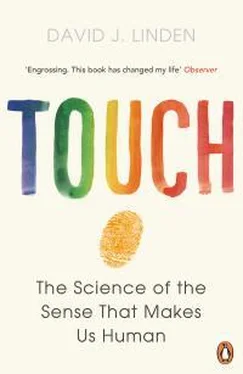5. This calculation assumes that the A-delta and C-fiber conduction speeds in dinosaurs are approximately similar to those found in birds, the modern survivors of the dinosaur lineage.
6. Our understanding of the molecular sensors for pain is still woefully incomplete. There have been claims that TRPV2 and TRPA1 have a role in sensing heat and cold pain, respectively, but the results with mutant mice engineered to lack these sensors have been equivocal. Likewise, we don’t know the molecular identity of the sensor for mechanical pain either, although there are some interesting candidates.
7. There is also a population of so-called “silent pain sensors.” There are C-fiber neurons that are normally responsive to heat but become sensitive to mechanical stimulation only in the context of injury. There are also some C-fibers that are not polymodal and that can sense thermal pain. It’s a complicated wiring diagram.
8. For an interesting reminiscence by the developer of the McGill Pain Questionnaire, see R. Melzack, “The McGill Pain Questionnaire,” Anesthesiology 103 (2005): 199–202.
9. For more details of the layered structure of the spinal dorsal horn as it relates to pain perception, see A. L. Basbaum, D. M. Bautista, G. Scherrer, and D. Julius, “Cellular and molecular mechanisms of pain,” Cell 139 (2009): 267–84.
10. How do we know that different types of pain information are kept largely separate in the initial stages of pain signaling? One example comes from experiments in mice in which TRPV1-expressing sensory neurons were selectively destroyed. These mice had a profound loss of heat pain but no change in their sensitivity to painful cold or mechanical stimuli. Conversely, selective destruction of a set of neurons expressing the gene MrgprD produces a deficit in mechanical pain with no change in heat sensitivity. D. J. Cavanaugh, H. Lee, L. Lo, S. D. Shields, M. J. Zylka, A. I. Basbaum, and D. J. Anderson, “Distinct subsets of unmyelinated primary sensory fibers mediate behavioral responses to noxious thermal and mechanical stimuli,” Proceedings of the National Academy of Sciences of the USA 106 (2009): 9075–80.
11. Other pain pathways include one that activates the cerebellum, which is involved in fine-tuning of movements and subconscious predictive control of the body.
12. As you can see in figure 6.4, the anterior cingulate cortex and the insula can also be activated in two other ways—directly from the thalamus or from the secondary somatosensory cortex—so the spinomesencephalic pathway isn’t the only way that these emotional pain centers get activated.
13. Most modes of brain scanning aren’t fast enough to resolve the difference between first and second pain. However, the technique called magnetoencephalography is. In the first experiment to clearly resolve regional brain activation in first and second pain, a laser beam was directed to the back of the hand to provide a repeatable (but nonscarring) painful stimulus together with magnetoencephalography. M. Ploner, J. Gross, L. Timmermann, and A. Schnitzler, “Cortical representation of first and second pain sensation in humans,” Proceedings of the National Academy of Sciences of the USA 99 (2001): 12444–48. For a more complete review of this topic, see P. Schweinhardt and M. C. Bushnell, “Pain imaging in health and disease—how far have we come?” Journal of Clinical Investigation 120 (2010): 3788–97.
14. The quotation is translated from the German in this original paper: P. Schilder and E. Stengel, “Schmerzasymbolie,” Zeitschrift fur die gesamte Neurologie und Psychiatrie (1928): 113, 143–58. The translation comes from C. Klein, “What pain asymbolia really shows,” http://www.colinklein.org/papers/AsymboliaWebVers.pdf, 2001.
15. M. F. Seidel and N. E. Lane, “Control of arthritis pain with anti-nerve-growth factor: risk and benefit,” Current Rheumatology Reports 14 (2012): 583–88. It may be that anti-NGF therapies will be useful, but only for a subset of patients where benefit of pain relief outweighs the negative consequences of accelerated joint degeneration.
16. In addition to persistent increases in the strength of spinal cord pain synapses evoked by tissue damage, there is another set of changes in the spinal dorsal horn evoked by damage to sensory nerves. Both are discussed in this useful review: J. Sandkühler and D. Gruber-Schoffnegger, “Hyperalgesia by synaptic long-term potentiation (LTP): an update,” Current Opinion in Pharmacology 12 (2012): 18–27.
17. These drugs are called N-methyl-D-aspartate (NMDA) receptor antagonists. They are one of several types of receptor for the excitatory neurotransmitter glutamate.
18. H. Flor, L. Nikolajsen, and T. Staehelin Jensen, “Phantom limb pain: a case of maladaptive CNS plasticity?” Nature Reviews Neuroscience 7 (2006): 873–81. It’s not clear if all the changes in the somatosensory cortex associated with phantom limb pain are exclusively consequences of changes in the spinal cord or if some of them develop independently.
19. The interview from which this section was adapted was conducted by CNN anchor Catherine Callaway and aired on February 8, 2004. The interview was with both Private Turner and Sergeant Neil Mulvaney, who led the team that evacuated Turner and the other wounded soldiers while they remained under fire. The transcript may be found at http://transcripts.cnn.com/TRANSCRIPTS/0402/08/sm.09.html.
20. H. K. Beecher, “Pain in men wounded in battle,” Annals of Surgery (1946): 96–105.
21. In this way, the brain reminds me of the G. W. Bush administration. If it hears about global warming, it sends down a message to NASA, “Shut up! I don’t want to know about that.” If it hears whispers of weapons of mass destruction in Iraq, it sends the message to the CIA, “Tell me more! Shout it out!”
22. If you’re wondering how structures in the brain get named, the answer is that it’s a hot mess. The early anatomists sometimes named structures using colors: locus coeruleus means “blue spot” (the same Latin root as cerulean blue pigment); or landmarks: periaqueductal gray is simply the gray matter “surrounding the aqueduct,” which is a narrow channel carrying fluid that runs through the core of the brain stem.
23. The actions of rostroventral medulla and locus coeruleus neurons to modulate transmission of pain signals in the spinal cord are complex and our understanding is incomplete. Some descending connections are received on the presynaptic terminals of pain-transmitting peripheral neurons, others on their targets in the spinal dorsal horn, and yet others on interneurons, which themselves release enkaphalins. Locus coeruleus neurons release the transmitter norepinephrine and some rostroventral medulla neurons release serotonin. A portion of the pain-blunting action of serotonin- and norepinephrine-boosting drugs (SSRIs and SNRIs) appears to result from their action in the spinal dorsal horn. While a portion of morphine’s analgesic action is in the periaqueductal gray region, local application of morphine to the spinal cord can also have useful analgesic effects, and so this is a common practice in hospitals, particularly after Cesarean births. For a useful overview of this topic, see M. H. Ossipov, G. O. Dussor, and F. Porreca, “Central modulation of pain,” Journal of Clinical Investigation 120 (2010): 3779–87.
24. Morphine and related drugs like oxycodone and heroin also activate the brain’s pleasure circuit—in particular, a key region called the ventral tegmental area. This is the basis of the euphoric effect produced by opiates and, ultimately, the basis of its addictive qualities.
25. M. C. Bushnell, M. Čeko, and L. A. Low, “Cognitive and emotional control of pain and its disruption in chronic pain,” Nature Reviews Neuroscience 14 (2013): 502–11.
Читать дальше












